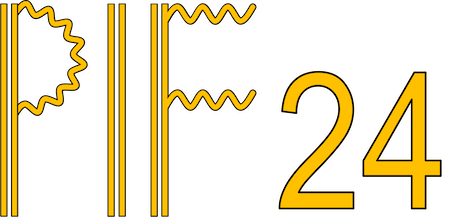Speaker
Description
Strong electromagnetic fields perturb the quantum fluctuations, thereby modifying the properties of the vacuum. This effect is called vacuum polarization. In QED, the thus emergent interaction is described by the second and the omitted higher-order terms in the Heisenberg-Euler action
$\qquad \qquad \qquad S = \! \int d^4x \left(
\frac{\mathfrak{F}}{4\pi} + \frac{\alpha}{360 \pi^2 E_c^2} \times
(4 \mathfrak{F}^2 + 7 \mathfrak{G}^2) + \dots \right),$
where $\mathfrak{F} = (E^2 - H^2) / 2$ and $\mathfrak{G} = \mathbf{E} \cdot \mathbf{H}$ are electromagnetic field invariants, ${E_c = 1.3 \cdot 10^{16} \, \text{V/cm}}$ is the critical field, and $\alpha$ is the fine structure constant. Radiative corrections $\mathcal{O}(\alpha)$ in $S$ introduce nonlinearity into the Maxwell's equations which results in a wide range of nonlinear optical phenomena, in particular photon-photon scattering. Their direct observation and measurement remain a long-standing challenge.
The most prospective all-optical setup involving three overlapping focused laser pulses has been studied since quite long ago [1]. Here a detectable signature reveals as an emission of the polarized vacuum which can be also viewed as a stimulated elastic photon-photon scattering. Combining three incoming pulses drastically stimulates the effect as compared to the earlier proposed two-pulse setups making it potentially observable at the currently or near-future available laser facilities. However, the collision geometries studied earlier were not optimized with respect to the direction of the emitted signal photons. Furthermore, the distributions of signal photons and their total number have been calculated only numerically for a partially or completely specified configuration of the collision scheme [2,3,4].
Our work generalizes previous considerations of three-pulse setups for detecting photon-photon scattering by deriving a fully analytical and general formula [5,6] for the yield of signal photons.
$~$
[1] R. L. Dewar, Physical Review A 10, 2107 (1974).
[2] E. Lundström et al., Physical review letters 96, 083602 (2006).
[3] H. Gies et al., Physical Review D 97, 076002 (2018).
[4] B. King et al., Physical Review A 98, 023817 (2018).
[5] A. V. Berezin and A. M. Fedotov, Bulletin of the Lebedev Physics Institute, 50(6), 641-651 (2023).
[6] A. V. Berezin and A. M. Fedotov, Physical Review D 110, 016009 (2024).

